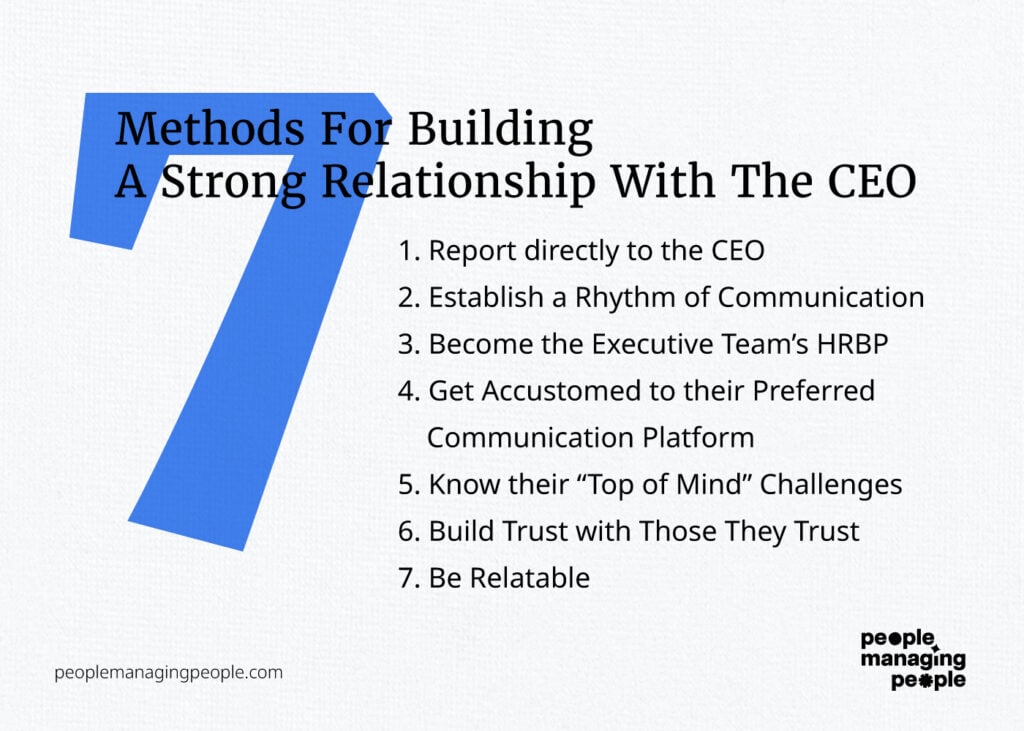The criticality of a closely-knit relationship between the Head of People and the CEO of an organization cannot be overstated.
But, despite the obviousness of this notion to HR leaders, it appears that executives need to be enlightened on this matter.
Allow me to illustrate this with an example of a blind spot that executives tend to have when their Head of People does not report directly to the CEO.
As an Interim VP, People and Culture, I once worked with a mortgage fintech organization where I reported to the COO.
I emphasized at the outset that the people initiatives the organization was seeking were intricate and that an HR leader was necessary to assist the CEO in dealing with these matters.
Achieving their objectives was impossible unless we modified the reporting structure to allow for this relationship.
Alas, that structure remained in place until the organization hit rock bottom. The challenges they were encountering were addressed, but the cultural norms that contributed to those challenges remained untouched.
Consequently, the COO struggled in their role, overwhelmed and unable to make a significant cultural impact from the top while losing their team and experiencing high attrition rates.
HR leaders are not miracle workers; progress is made only through people. Without the opportunity to develop the necessary relationships, even the most skilled HR professionals will find it difficult to make real impact.
Fortunately, the reporting structure was eventually revised, and I began reporting to the CEO.
Working closely with the COO, I was able to have meaningful, human conversations with the CEO about culture. As a result, perceptions of the employee experience began to improve and the root causes of the organization's challenges were addressed.
It’s essential to bear in mind that this is merely one instance where a lack of relationship between the Head of People and the CEO has led to problems. As an HR professional focused on impacting meaningful change, this is a relationship you have to cultivate.
Here is how, over time, I developed the required relationship.
7 Methods For Building A Strong Relationship With The CEO

1. Report directly to the CEO
As highlighted in the above example, this is important. But, before approaching the CEO to request to report to them, it's essential to work with your current manager and ensure that you’re aligned.
To persuade your manager and the CEO to change the structure, you must first establish a strong case for how this change would benefit the organization.
This includes demonstrating your ability to contribute to the CEO's strategic priorities and goals, highlighting your unique skillset and experience, and showing your commitment to the organization's mission and values.
It's also essential to have a clear and compelling vision for how the new reporting structure would work, including a detailed plan for how you would collaborate with the CEO and other stakeholders.
Finally, you should be prepared to address any concerns or objections your manager or the CEO may have and be ready to explain why this change is necessary for the organization's success.
It’s certainly plausible that apprehension may arise regarding the CFO or COO's underutilization in the event of the change in reporting structure. The notion that they may not be fulfilling their potential or that their expertise and skillset are not being fully utilized could be a cause for concern.
To address this, I’d explain that the change in reporting structure is not intended to diminish the role or responsibilities of the CFO or COO, but rather to create a more effective and streamlined structure for managing human resources operations.
By reporting directly to the CEO, it ensures that the company's HR initiatives are aligned with its overall goals and vision and that resources are being used effectively.
This can help the CFO or COO focus on their core competencies and responsibilities while allowing you to manage HR-related issues more efficiently.
Another probable objection to the proposed change is apprehension regarding an augmented workload for the CEO. The possible added burden on the CEO's already busy schedule, and the potential stress it could cause, may generate apprehension and resistance towards the change.
I’d address this concern by presenting a clear plan for how the change in reporting structure will be implemented, including details on how it will affect the CEO's workload and responsibilities.
This could involve providing specific examples of how you might take over some of the tasks that were previously handled by your manager, such as talent acquisition, employee retention, and training and development.
You can also highlight how the change will lead to faster decision-making and improved communication, which will ultimately reduce the workload for everyone involved.
By addressing these concerns in a thoughtful and thorough manner, you can illustrate why the change in reporting structure is a positive and necessary decision for the organization.
By approaching this conversation with confidence, preparation, and a strategic mindset, you can increase your chances of convincing them to let you report to them.
2. Establish a Rhythm of Communication
I'm keen on instituting a customary meeting with the CEO as it serves as a splendid medium to cultivate an affinity and maintain the salience of human resources and talent management.
By organizing a recurring meeting, you’re able to establish a methodical and unvarying approach to deliberating HR-related matters and perpetuate a steady cadence of communication.
I’d advise arranging a weekly or fortnightly one-on-one, lasting no more than 30 minutes, in addition to the executive team's collective customary meeting.
This meeting provides a platform to address intricate HR predicaments that necessitate nuanced attention or may be inappropriate for discussion in a larger setting.
3. Become the Executive Team’s HRBP
In my role as the Head of People, I'm entrusted with the task of overseeing the organization's people strategy while also providing counsel and assistance to the executive team.
As the HR business partner to the team, I embrace a dual persona—that of a coach and peer—in order to assist the CEO in maintaining an engaged and high-performing executive team.
An example of my support is providing guidance on communicating sensitive information to the team, or coaching the CEO on how to navigate challenging conversations with team members.
4. Get Accustomed to their Preferred Communication Platform
Comprehending the CEO's favored method of communication is crucial to fostering a robust relationship.
Some CEOs may incline toward direct interaction, while others may show a preference for digital platforms such as email, Slack, or Teams.
By grasping the CEO's preferred communication style, I can adjust my approach to ensure maximal efficacy.
For instance, in the case of the former, I will strive to request in-person meetings whenever viable, thereby forging a more personal connection.
Conversely, in the case of the latter, I might furnish regular updates or reports via email to keep the CEO duly informed.
5. Know their “Top of Mind” Challenges
Comprehension of the CEO's imperatives and predicaments is pivotal to forging a robust rapport. I prioritize investing time in comprehensively understanding their focal points, both on a personal and professional level.
If the CEO's agenda centers on burgeoning the business, I would shift my focus on devising strategies to attract and retain high-performing employees to propel the company's expansion.
Conversely, if the CEO is concerned about employee engagement or high turnover, I would explore methods to enhance the organizational culture and augment the employee experience.
6. Build Trust with Those They Trust
Recognizing the individuals whom the CEO confides in and fostering connections with them is an effective strategy to cultivate credibility and wield influence within the organization. By establishing trust with key stakeholders, I can establish myself as a reliable counselor.
To illustrate, I conscientiously cultivate rapport with members of the executive team or influential figures in various departments to build coalitions and solicit endorsement for HR initiatives.
This approach is likewise an advantageous tactic to identify critical issues that the organization will be more receptive to tackling.
7. Be Relatable
Identifying mutual interests or hobbies that I share with the CEO can be a fruitful tactic in establishing rapport and amiable interactions.
This strategy fosters a personal connection and strengthens our relationship by virtue of shared interests.
For instance, if the CEO is an avid enthusiast of a particular sports team or loves hiking, I may relay personal anecdotes or observations linked to those areas.
Through this approach, I can forge a more organic and personable connection that transcends the traditional employer-employee dynamic.
Forging An Alliance Vital For Organizational Success
A close alliance between the Head of People and the CEO is vital for organizational success.
A case in point is my earlier example of the mortgage fintech company where I, as the Interim VP, People and Culture, reported to the COO instead of the CEO, leading to significant challenges and cultural issues. Only when the reporting structure was revised, and I began reporting directly to the CEO, did meaningful progress occur.
By fostering this relationship, you’ll be able to more effectively address people-related challenges, improve culture, and align HR initiatives with strategic goals, ultimately driving positive outcomes.
If you’re looking for cultural transformation, executive coaching, talent management strategies, or HR strategic support from a Global Sr. Executive HR Consultant, please feel free to reach out on Linkedin or in the People Managing People Community.
Further resources to help you implement change as an HR leader:


